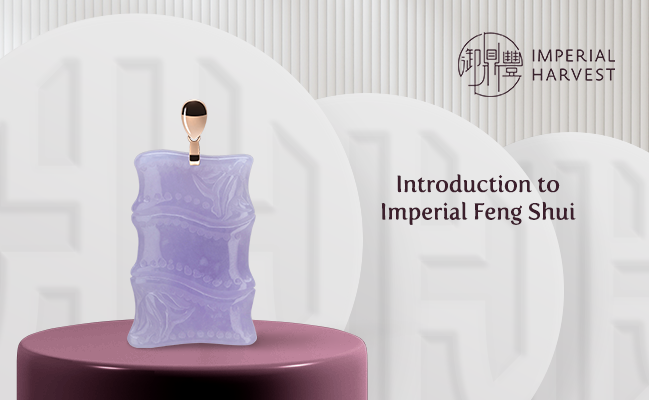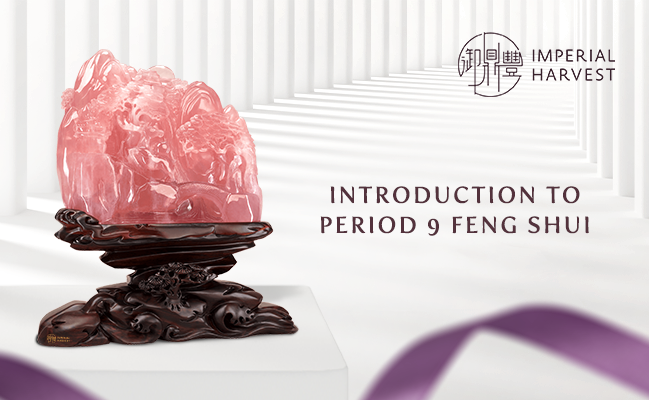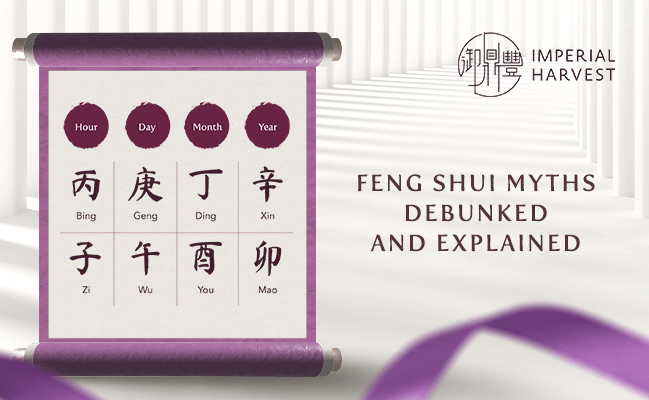

Posted by Imperial Harvest on 14 April 2023
A Comprehensive Guide to the History of Bazi (八字)
Estimated Reading Time: 5 mins
Bazi (八字) is often mistakenly assumed as the Chinese counterpart of western Astrology. The similarities between both systems lie in their utilisation of birth dates and time in their calculations, and the ability to be read from a tabulated chart. Where Astrology may take into account the positions of different planets, Bazi solely takes into consideration the position of the Sun, relative to an individual’s birth information, as it bears the greatest influence over the circumstances of the Earth’s climate.
What is Bazi?
Bazi, translated literally as the “Eight Characters”, is a Chinese concept that is a key foundational cornerstone in the study of Imperial Feng Shui. Each Bazi chart is unique, varying from person to person, and consists of three main segments:
- The Composition of the Eight Characters
- The Life Cycle (大运)
- The Current Year (流年)
Bazi focuses on the unique characteristics surrounding an individual’s birth year, month, date and hour of birth — using these factors to interpret their destiny, personality, relationships, interaction with the environment, and even their strengths, weaknesses, opportunities and risks.
Comprising of the Ten Heavenly Stems (天干) and Twelve Earthly Branches (地支), a Bazi chart is structured according to the Four Pillars (四柱命理) — the Year, Month, Day and Hour pillars.
- The Year Pillar (年柱): refers to the lunisolar year, starting from Lichun (立春) or the beginning of Spring
- The Month Pillar (月柱): refers to each of the twelve months in the year
- The Day Pillar (日柱): refers to any of the 365 days of the calendar
- The Hour Pillar (时柱): refers to the 12 bi-hourly segments of each day, according to the individual’s time of birth
In Chinese metaphysics, Qi (气) is a time-honoured concept, thought of as the primary essence of all living things and the universe itself. The life force and energy that flows in humans, all living things and the cosmos alike is the product of the movement of Qi and its interactions with the natural world.
In the study of Bazi, Qi is mapped and represented through a combination of 22 characters known as the Ten Heavenly Stems and Twelve Earthly Branches. Each of the 10 Heavenly Stems is associated with an element and a Yin-Yang polarity, whereas the 12 Earthly Branches are associated with each zodiac sign, and is further associated with an element, bi-hourly timing, seasonal and directional system.
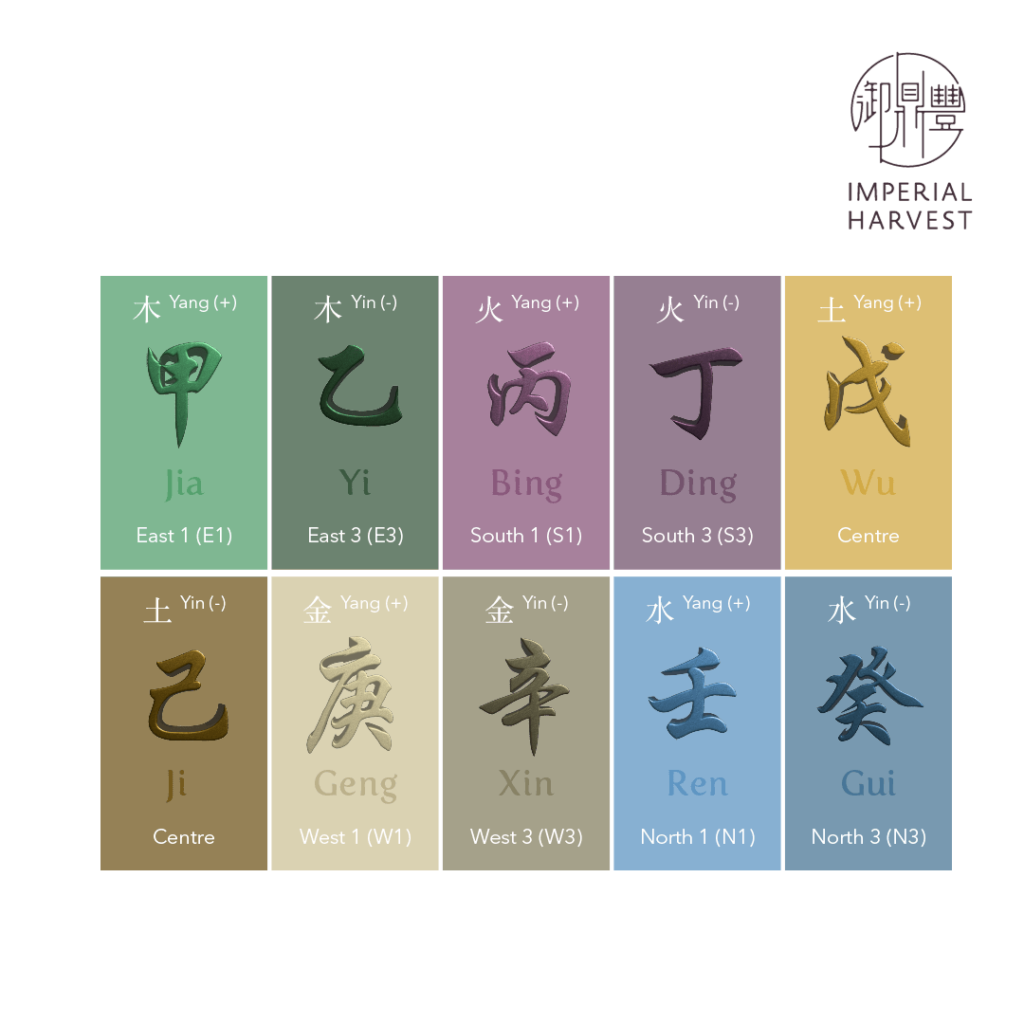
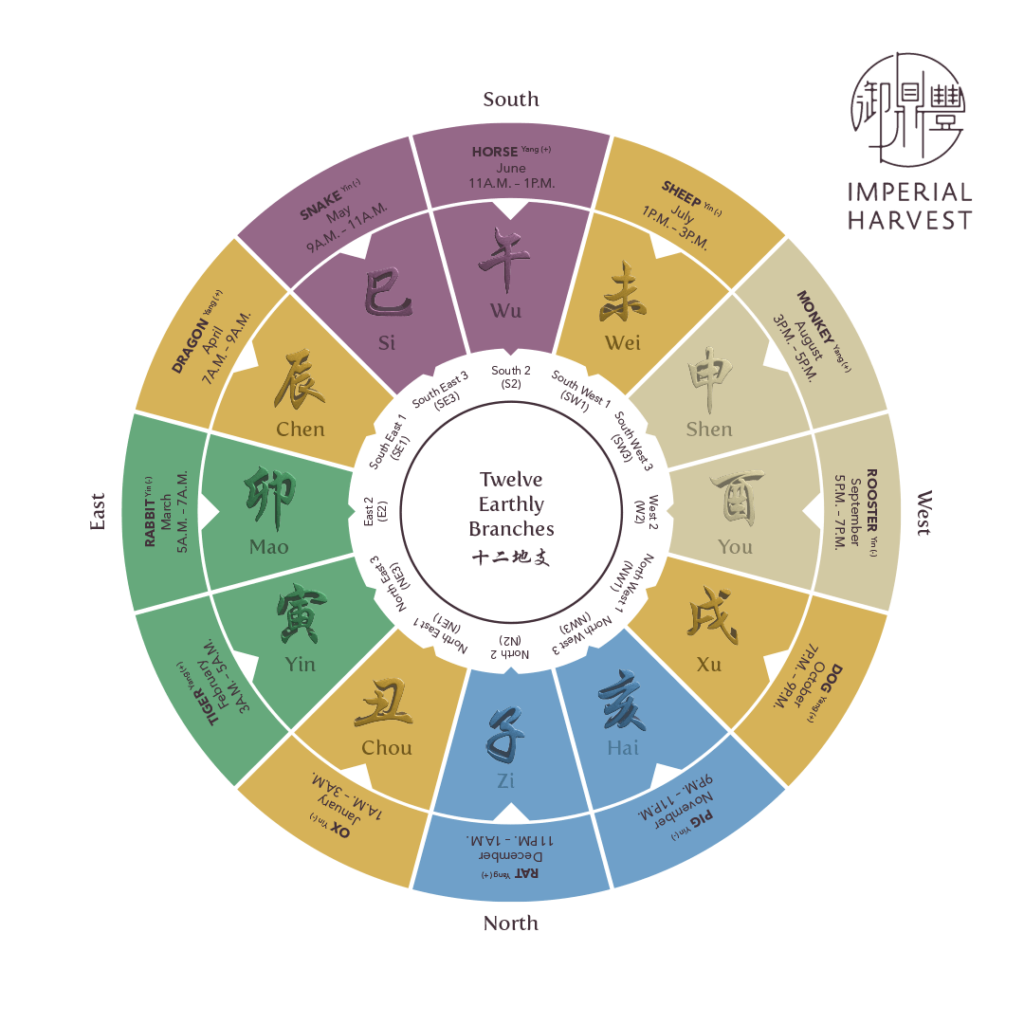
Two prominent positions exist within the 10 Heavenly Stems and 12 Earthly Branches; an individual’s Daymaster (日主) which refers to the Heavenly Stem of the Day Pillar, and the Month Commander (月令) which refers to the Earthly Branch of the Month Pillar.
Historical and Contemporary Applications of Bazi
Since the Northern Song dynasty, Imperial Feng Shui masters have analysed the Bazi profiles of royal family members to help them achieve wealth, health, harmony and longevity through the application of Imperial Feng Shui.
As social, economic and cultural norms evolve over the centuries, the studies of Bazi have evolved and adapted to help our clients thrive and flourish in modern society.

For sales professionals, understanding your Bazi chart helps to understand your sales personality and assists in the development of winning marketing strategies to advance your products and services. Additionally, it also allows you to better understand your clients and the types of profiles and personalities that have strong working chemistry with you.
For career professionals, an understanding of Bazi fosters the development of good chemistry with colleagues and superiors. It helps you in achieving stellar results in your work performance, and maintain consistent career progress.
For entrepreneurs, Bazi helps in the identification of potential industry partners, and the feasibility of business ideas and facilitates in identifying the optimal timing to launch your business, based on your luck trends.
For parents, Bazi is also used as a guiding tool, directing their children towards positive goals, aspirations and achievements in their lives.
Historical Overview of Bazi
From a historical point of view, the vast history behind Bazi is a result of the longstanding efforts of eminent Chinese scholars dedicated to building and rationalising the cumulative study of this major metaphysical concept.
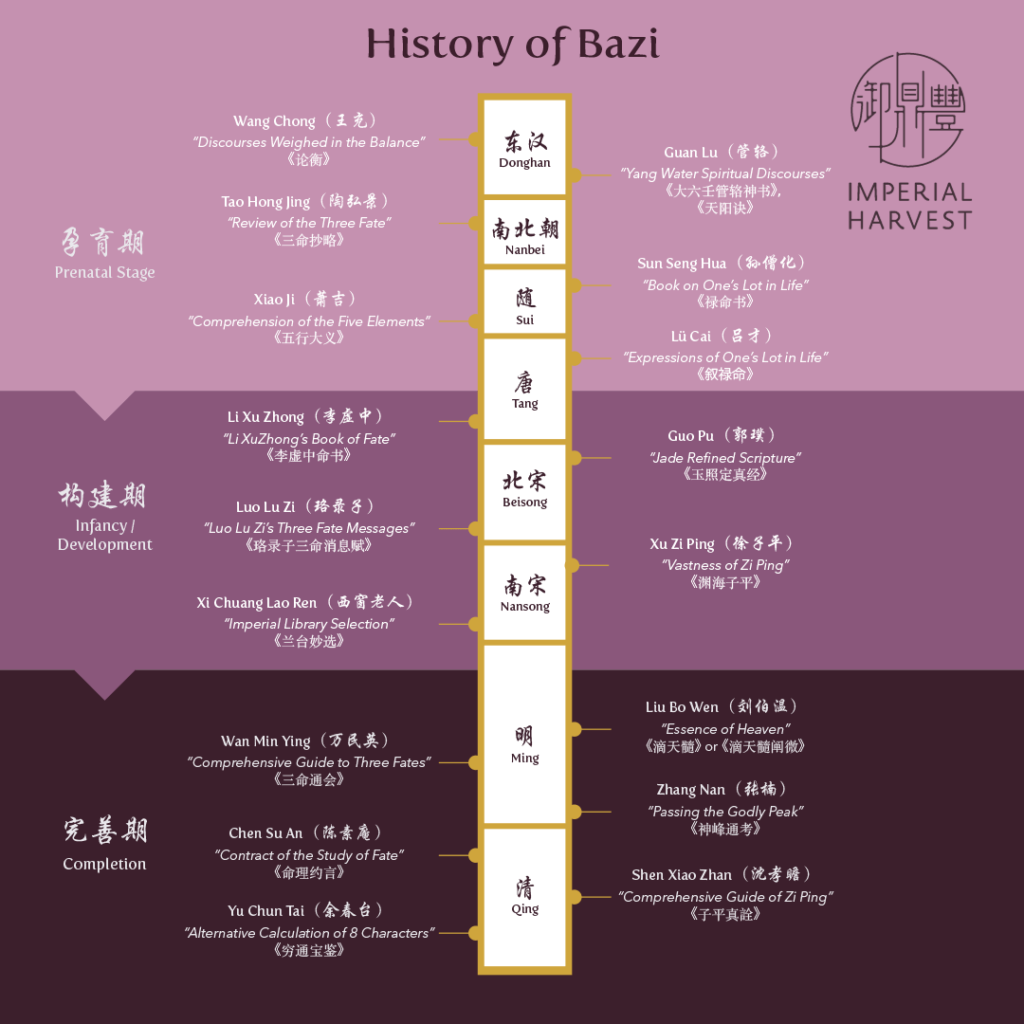
A classical study dating back to the Tang dynasty (618 to 907 AD), the depth and vastness of traditional Bazi studies are comparable to the similar depth of Chinese history. It was during the Eastern Han dynasty (25 to 220AD) that the scholar, Wang Chong (王充) proposed that Qi was the energy flowing within an individual’s body — a concept that lasted until the end of the Qing dynasty in 1911. In its centuries-long development, the conception of Bazi may be divided into three major developmental stages.
The initial conceptualisation stage of Bazi theory ranges from the Han dynasty’s “Discourses Weighed in the Balance 《論衡》” to the Tang dynasty’s “Li Xuzhong’s Book of Fate 《李虛中命书》”.
This stage is followed by the developmental stage, which is marked by the completion of the Ming dynasty’s “Discourse of the Three Lives Flow 《三命通會》”. Lastly, the finalisation phase of Bazi’s theory culminates in the completion of the “Discourse of the Three Lives Flow 《三命通會》” at the end of the Qing dynasty — a text rounding out the study and system of what is now commonly known as Eight Characters (八字).
The Evolution of Bazi
The long and varied history of Bazi studies often references the following literary texts, marking the guiding cornerstones of this enigmatic branch of Chinese metaphysics.
《子平真詮》(zi píng zhēn quán)
Originally authored by Shen Xiaozhan (沈孝瞻), a scholar active during Emperor Qianlong’s reign during the Qing dynasty, 《子平真詮》provides a comprehensive framework to evaluate the structure (格局) of a Bazi chart, facilitating the understanding of the potential, aptitude and ability of an individual based on the Useful God (用神) and Luck Cycle. This renowned text offers guiding principles to map out the family tree in a Bazi chart, known as the Six Kins, and predict any potential issues that arise.
Chapters 1 to 7 of this text explain the origins of the Five Elements, the Ten Heavenly Stems and the Twelve Earthly Branches. It provides a systematic framework to evaluate the strength and interaction between the Heavenly Stems, Earthly Branches and Ten Gods as derived from an individual’s Daymaster.
Chapters 8 to 22 cover the concept of Useful God (用神), and how it can influence the potential, aptitude and abilities of an individual (格局). These chapters explore the concept of Minister God (相神), and how auspicious or inauspicious Gods can influence an individual, resulting in high calibre or low calibre Structure (成格/败格) — refers to an individual’s potential, aptitude and ability.
Chapters 23 to 30 pose the method to assign the Heavenly Stems and Earthly Branches to the Six Kins, or the Chinese family tree, and methods to analyse issues of the Six Kins. These chapters also explore the relationship between Luck Cycles (行运) and the Structure of a Bazi Chart (格局).
Chapters 31 to 48 form the definitions and applications of the Four Auspicious Gods (吉神) and the Inauspicious Gods (凶神). It covers the application of the Ten Gods as Useful Gods in specific structures and life events.
《渊海子平》(yuān hǎi zi píng)
A Chinese classic from the Song dynasty compiled by Xu Da Sheng (徐大升), 《渊海子平》was the first of its kind to capture and describe the system of calculating and divining an individual’s life journey through the use of the Four Pillars of Destiny, Heavenly Stems and Earthly Branches and the Five Elements. Remaining one of the foremost literary references for most practitioners, this text builds upon the pillar calculation system proposed by Lee Xu Zhong (李虚中). This text posits an individual’s Daymaster as the main factor in a Bazi chart, and the remaining pillars as supporting elements.
《三命通会》(sān mìng tōng hùi)
Authored by the Ming dynasty imperial scholar, Wan Min Ying (万民英), this classical Chinese text《三命通会》was highly commended in a Qing dynasty curation of literature studies (四库全书). This text has a total of 12 chapters, with the first nine listing out the 10 Heavenly Stem, descriptions of Daymasters and Month Commanders — detailing the strengths and weaknesses of an individual. The remaining three chapters document a large volume of related prose, poetry and examples of application.
《穷通宝鉴》(qióng tōng bǎo jiàn)
Compiled by Yu Chuntai (余春台) during the Qing dynasty, 《穷通宝鉴》is one of the most prominent literary texts in the study of Bazi. The text puts forth the notion of fate adjustment, theorises the importance of the relationship between Daymasters and Month Commanders, and summarises them in the context of the Five Elements. Its main theories bring to the forefront the basic natures of the Five Elements, their elemental interactions and considerations.
《滴天髓》(dī tiān suǐ)
The origins of this text are linked to Liu Ji (劉基), also known as Liu Bowen (劉伯溫), a renowned minister during the reign of the first Ming dynasty Emperor.《滴天髓》includes descriptions and explanations of both Yin-Yang polarities of Five Elements, delving in-depth into the theories behind the Heavenly Stems and Earthly Branches. The text details the different parts of a Bazi chart, and the stars that govern each individual.
Book a complimentary Bazi consultation with Imperial Harvest
At Imperial Harvest, each journey begins with a Bazi consultation. Drawing upon profound insights and principles garnered from the aforementioned key pieces of literature, Master David adapts these time-honoured principles, applying them in a contemporary socio-economic context.
With these concepts written during the Song, Ming and Qing dynasties, Master David channels this multi-generational lineage in distilling their Imperial Feng Shui wisdom, while simultaneously offering bespoke and effective practical solutions in the form of the finest and most exquisite Imperial Feng Shui treasures — Imperial Harvest-grade Sandalwood, Agarwood and Jadeite.
Imperial Harvest’s expert consultants are always on hand to guide you on your journey and provide you with insights to help you realise your fullest potential. Book a complimentary consultation today or contact us at +65 92301640.
We are located at
For prospective clients:Imperial Harvest402 Orchard Road
Delfi Orchard #02-07/08
Singapore 238876 For existing clients:Imperial Harvest Prestige
402 Orchard Road
Delfi Orchard #03-24/25
Singapore 238876
Most Read Articles
Get to read our life changing articles and get inspired.

Imperial Harvest Consecration Ceremony
Estimated Reading Time: 5 mins At Imperial Harvest, each earthly treasure undergoes a series of consecration rites performed by Master David, before it is bestowed upon its blessed owner. Every aspect of these sacred Chinese anointing rituals is carefully examined and accurately represented in Master David’s blessings, reflecting Imperial Harvest’s deep respect for these esteemed […]

The Importance of Mountain and Water Stars
Estimated Reading Time: 4 mins “山管人丁,水管财”, is a well-cited principle in the study of Imperial Feng Shui that translates to “Mountains govern benefactors, authority and harmony, while Water governs wealth, opportunities and intuition”. This principle reiterates a critical factor in Imperial Feng Shui — balance is the key to achieving success in life. As mountain […]

Imperial Harvest QING Collection
Estimated Reading Time: 4 mins The Imperial Harvest Qing collection exemplifies the brand’s dedication to artistry and cultural heritage, with each piece meticulously crafted by hand from raw jadeite boulders, demonstrating an unparalleled level of craftsmanship. Master David, inspired by the profound principles of Imperial Feng Shui and Chinese Metaphysics, personally designs each ring, pendant […]
